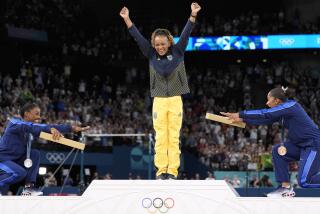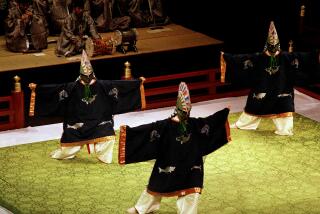At the Dawn
- Share via
On a museum table at the scene of the ancient Olympic Games in Olympia, Greece, there is a scale model of the Olympia that used to be, incorporating temples, monuments and colonnaded theaters.
Surprisingly, though, the renowned old Olympia Stadium is off to one side, a small vale overshadowed by imposing structures. Athletics, apparently, were only part of life in old Olympia.
To step out onto the ancient playing field itself, however, is to enter the world where big-time sports began. The field is a narrow rectangle, twice as long as an American football field but half as wide, and carefully built for the main event, a sprint on an approximate 220-yard straight.
The old, long, thin start-finish lines are both still there, with toeholds cleverly carved in limestone rows at each end of the course, for 20 starters abreast.
Looking around, though, one understands why the original Olympia Stadium is so inconspicuous on the museum scale model. Built without seats, it looks more like a big hole in the ground than a stadium.
In the country where the ancient Olympics were born and where the modern Olympics are scheduled to return for two weeks in August, the old Greeks offered only hillside-lawn seating to the sports fans of the 5th century B.C.
Olympia was the sports capital of the world the summer that the earth was piled up on all four sides of the field to form sloping embankments where crowds of perhaps 45,000 sat on the grass.
The Olympics flourished under their early name, Olympian Games, in those years when the center of all the action was Olympia’s straightaway 220, a distance known to early Greek sprinters as a stadion (hence stadium). Longer races were multiple stadions, raced back and forth, like a swimming race.
Even then, their stadium was historic, because:
* Footracing had originated at Olympia Stadium in remote antiquity -- long before anyone called it an Olympic event, even before anyone was compiling winners’ names.
* The first recorded Olympic champion, Koryvos, won the featured stadion in 776 B.C.
* The oldest measured mark in track and field is chiseled into an Olympia stone. It is the equivalent of 23 feet 1 1/2 inches, Chionis’ winning long jump in 656 B.C.
Koryvos, Chionis and their rivals entered the stadium through a ground-level tunnel much like the one at the Los Angeles Coliseum. The early Olympians, however, ran past small statues the Greeks called Zannes, models of the god Zeus. These were paid for with fines collected from athletes who cheated. Some things never change.
But some do. At old Olympia, the athletes came down that tunnel nude. They ran or jumped unencumbered by robes, cloaks or even shorts.
The women of those early times had to sit out sports events. Historians at the University of Athens have determined that two groups of people were barred from playing or watching games -- undesirables, most of them slaves or convicts, and women. It was a free man’s world.
Fun Time in Old Greece
Visitors in Greece can still find much that’s left of the playgrounds the Greeks constructed thousands of years ago at Nemea, Corinth, Athens, Olympia, Delphi and other Greek city-states.
Those people did love to play. And during their great sports festivals, they played grandly.
They held their four major festivals at regular intervals, the Olympian and Pythian Games every four years and the Isthmian and Nemean Games every two. And there was big-time competition somewhere every year.
The modern presentation of the Olympics every fourth year -- a tradition established a century ago by Pierre de Coubertin -- probably was the result of misplaced emphasis on the cycle at Olympia. To the sports fans and competitors of ancient Greece, their three other spectacles were just as important as the Olympics. The Greeks were not the type to wait four years to play.
The most impressive of their playing fields wasn’t at Olympia or Athens, but at the site of their Pythian Games, Delphi. Mythology says that in the 8th century B.C., Zeus loosed two eagles with instructions to find the center of the universe and both landed where Delphi was laid out in central Greece. The city and its playgrounds were built into the side of graceful, forested Mt. Parnassus, and there, tier on tier, the orderly ruins of Delphi still rise.
Significant about all this, historians say, is that in the prime years of ancient Greece, life was extensively coordinated, much more so than in 21st-century America.
The ancient Greek citizen often doubled as spectator and participant in one or more of the games. And in that day, “game” was understood to mean contests in music, poetry, theatrics and other arts, as well as sports.
Spyriden Papaspyropoulos, for many years director of ancient studies at the University of Athens, taught that, “The ancient Greeks believed that human beings are three things in one -- mind, body, and spirit -- and that all three should be developed equally. Therefore, in school, they spent as much time on music as mathematics, and they boxed and wrestled as often as they competed in [debating].
“Their ideal was the man of well-balance, -- the sound mind in the sound body. They played hard, but they also studied hard. Many of their best poets, musicians, and writers of plays were also great soldiers and great athletes.”
Land of Ups and Downs
For years, most Olympic champions became instant pros, going on the payrolls of grateful city-states, often for life.
Why Greece? Simple games and races are probably as old as mankind, but the ancient Greeks organized athletic competition. How did that come about? And why, after 10 centuries of competition, did the Olympics disappear, not to reappear for another 10 centuries?
Most explanations for the beginning of the first Olympic era, as well as the ending, take heavily into account geography, economics and religion:
* The ancient Greeks, with a common language and heritage, inhabited an uncommonly disparate area that was difficult to unify and, hence, receptive to widely dispersed city-states.
* On that foundation, they built the world’s first society combining considerable economic well-being with considerable individual freedom -- instead of absolute conformity to authority and custom -- thus creating the first leisure class big enough for organized competitive games.
* Centuries later, reaching the end of a run that had been sustained from 776 B.C. to 394 A.D., the Olympics expired for a reason that historians note was a familiar one: establishment repression.
By then, the underlying strength of the Greeks, their web of robust little city-states, had become a weakness. They couldn’t -- or wouldn’t -- consolidate militarily in time to resist a powerful common enemy, Rome. Then Christianity came to Rome. And, shortly, the destruction of the Olympics and all other Greek festivals was enforced, historians say, by invincible combinations of religious and secular authorities.
In Olympia’s heyday, that kind of force had been weak or absent. According to research by Prof. Minos Kokolakis at the University of Athens, in old Greece, “There was no all-powerful church establishment of the kind that [took hold] in Egypt and other civilizations earlier and Rome and other civilizations later.”
It wasn’t happenstance, Kokolakis suggested, that ancient Greece thrived “in the millennium that climaxed the long polytheistic ages.”
Indeed, a vital precondition for the Greeks’ breakthrough athletic achievement seems to have been their relaxed form of worshiping -- or at least acknowledging -- many gods.
Athens journalist John Rigos, a student of ancient times, once observed, “There were so many gods in old Greece that they couldn’t all be offended by sports.”
Still, the polytheistic Greeks turned out to be as fragile as every other civilization in recorded history. And after their games were suppressed, the Olympics were hardly a memory for hundreds of years.
Not until 1500 A.D. was there a revival of Greek ideals and refinements, which, that time around, were visible first in the arts and literature with the European Renaissance.
Democracy, the imaginative political invention of the Greeks, returned next, distinguishing the last years of the 18th century -- in America, first, and then, gradually, elsewhere.
At last, in the late 19th century, the world again began to play.
It is significant that the sports comeback happened only after an intellectual comeback, the rise and growth of the modern university. In the late 19th and early 20th centuries, widespread university emphasis on intellectual inquiry finally distilled an environment in which the old Greeks would have felt at home.
In sum, the modern world has reproduced the essential components of the ancient Greek world: some prosperity, some free thinkers -- enough, at least, to contest established beliefs -- and a reasonably free society with the leisure for games.
On the present massive U.S. scale, the age of play is about as new as airplanes, having begun about a century ago. Brief as it has been, though, there has been nothing else like it anywhere on the planet, since humanity emerged from the caves, save an improbable era in the land of Zeus.
More to Read
Go beyond the scoreboard
Get the latest on L.A.'s teams in the daily Sports Report newsletter.
You may occasionally receive promotional content from the Los Angeles Times.






